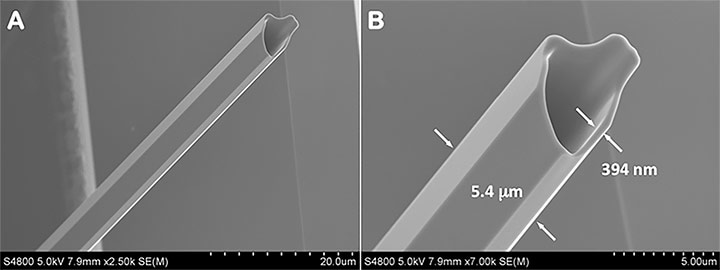Aug 29 2016
Researchers from the National Institute of Standards and Technology (NIST) and China’s Shandong University have been involved in crystal research which is predicted to have a positive impact on laser applications. They have found a probable way to avoid old difficulties related to producing the crystals that are a vital part of laser technology. However, the science surrounding this finding has puzzled experts.
 These potassium diphosphate (KDP) crystals, which self-assemble in solution as hollow hexagonal rods, could find use in laser technology, particularly for fiber-optic communications. The scanning-electron image at right shows a crystal at higher resolution with scale added. (Photo credit: L. Deng / NIST)
These potassium diphosphate (KDP) crystals, which self-assemble in solution as hollow hexagonal rods, could find use in laser technology, particularly for fiber-optic communications. The scanning-electron image at right shows a crystal at higher resolution with scale added. (Photo credit: L. Deng / NIST)
The research findings have been published in Science Advances and indicate that the relatively large crystals used to modify various properties of light in lasers could be formed by stacking up far smaller, rod-shaped microcrystals that can be grown easily at low cost. These modifications are vital for transforming lasers into practical tools.
At the moment, the microcrystals created by the team outperform conventional crystals in certain aspects, thus indicating that harnessing them could give rise to the formulation of quick, economical method to develop large crystals that would otherwise be time-consuming and expensive to produce.
However, these microcrystals challenge traditional scientific theory as to the reason why they perform the way they do. The color of light seen in a laser is frequently different than the one it originally produces. Several lasers produce infrared light, which then passes via a crystal converting its energy – and consequently its wavelength – to light of a visible color such as blue or green.
Commonly, that crystal is composed of potassium diphosphate (KDP), a standard material possessing properties that make it very useful. A KDP crystal is capable of not only modifying the color of light but also serves as a switch that modifies the polarization of light or prevents it from passing via the crystal until the exact moment.
The data carried by laser light via fiber-optic cables relies upon the polarization of light, and quite a lot of applications depend on the timing of a laser pulse.
Small KDP crystals are simple to produce, and these can be utilized in both telecommunications systems and pocket laser pointers. However for higher-energy applications, researchers for years have been hunting for a method to create large, high-quality crystals that can endure frequent exposure to powerful laser pulses, but a solution has remained indefinable.
The team has achieved practical results by growing KDP crystals in solution. These crystals take the form of hexagonal-shaped hollow tubes and long rods measuring a few micrometers in width. These KDP microcrystals possess an energy-conversion efficiency outperforming even the finest KDP crystals under the same conditions, increasing the likelihood of directly growing crystals for use in telecommunications.
The team also recommends the rods can be placed one over that other like firewood, constructing a larger piece out of billions of the miniature filaments. prior to being stacked, they can be coated with a thin layer of conductive material that transfers heat away, making them capable of enduring recurring pulses of high-intensity laser light – potentially widening their application range if a way can be discovered to pile them.
The ambiguity lies behind why the microcrystals act as they do. Fundamental physics states that it is not possible. Conventional physics models specify that an optical medium such as a crystal will not be symmetric about its center if it is to convert energy efficiently, yet these microcrystals seem to override this rule.
We’ve spoken to a number of experts in different fields worldwide, and none of them can explain it. Currently, no theory can explain the initial growth mechanism of this exotic crystal. It’s challenging our current understanding in fields from crystallography to condensed matter physics.
NIST physicist Lu Deng
Deng said going forward the team will be focused on the engineering issues related to growing stackable microcrystal rods.
We can grow more than 1,000 microstructures every 10 minutes or so on a single glass slide, so growing a large amount is not a problem. What we need to figure out is how to grow a large fraction of them with nearly uniform cross-sections since that will be important in the final assembly stage.